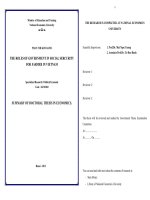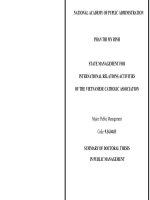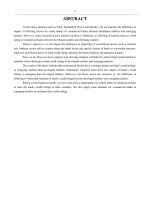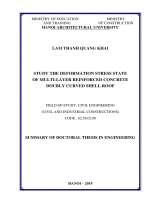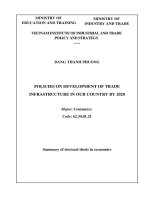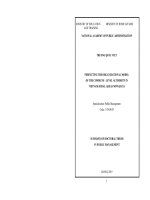Summary of Doctoral thesis in Economics: The solutions to prevent corporate income tax losses in Hai Phong city
Bạn đang xem bản rút gọn của tài liệu. Xem và tải ngay bản đầy đủ của tài liệu tại đây (489.64 KB, 29 trang )
MINISTRY OF EDUCATION
AND TRAINING
MINISTRY OF FINANCE
ACADEMY OF FINANCE
TO VAN TUAN
THE SOLUTIONS TO PREVENT CORPORATE INCOME TAX LOSSES IN
HAI PHONG CITY
Major: Finance Banking Code: 9.34.02.01
SUMMARY OF DOCTORAL THESIS IN ECONOMICS
HA NOI 2020
The thesis was completed at the Academy of Finance
Scientific advisors:
1. PhD. NGUYEN DINH CHIEN
2. PhD. NGUYEN THI THU HUONG
Examiner 1:
Examiner 2:
Examiner 3:
The thesis is to be presented at the thesis council at academy level
held at the Academy of Finance
At.....hour.....day.........month.......year 2020
The thesis is available at the National Library of Vietnam
and the library of the Academy of Finance
INTRODUCTION
1. The rationale of the research topic
In the tax system, corporate income tax is a tax that regulates directly on
taxable income of businesses and often accounts for a large proportion of the
total state budget revenue. As the main goal of business is to increase profits
and benefits after taxes, firms often apply various measures to save costs and
reduce the amount of tax payable to the state budget, including the practice of
tax fraud, tax evasion and tax avoidance. Hai Phong city is a port and industrial
city in Northern Vietnam and a coastal city located in the Northern coastal
region. In the past few years, implementing the multisectoral economic
development policy and the introduction of the 2005 Enterprise Law, the
number of enterprises in the city has increased rapidly. According to
summarized reports from 2014 to 2019, the situation of loss of corporate
income tax is still a problem due to limitations in policies, mechanisms and
implementation procedures in Hai Phong city. Therefore, solutions to
administer tax in general and prevent tax losses in particular are not only
effective for Hai Phong City’s tax industry but also important solutions for tax
administration in Vietnam as well as in other localities. A mentioned above, the
thesis topic: "Solutions to prevent corporate income tax losses in Hai Phong
city" has scientific and practical contribution to the existing field.
2. Research objectives
General objective: Proposing a system of solutions to prevent the loss of
corporate income tax in Hai Phong city to 2025, vision to 2030.
Specific objectives:
1. Systematizing, developing and supplementing theoretical issues on loss
of corporate income tax, clarifies the forms of corporate income tax fraud
leading to the loss of corporate income tax, points out the cause of the loss of
corporate income tax. Also, the thesis studies theoretical issues on antiloss of
corporate income tax and clearly specifying the contents and factors affecting
the antitax revenue reduction activities of tax agencies.
2. Drawing lessons on preventing the loss of corporate income tax in
Vietnam as well as for tax administration in general and Hai Phong Tax
Department in particular on the basis of researching international experience in
combating the loss of corporate income tax of a number of countries in the
world.
3. Analyzing the current situation of corporate income tax fraud and anti
loss of corporate income tax in Hai Phong city in the period of 2014 – 2019 and
depicting the successes, limitations and causes of limitations in this work.
4. Proposing effective solutions to prevent the loss of corporate income tax
in Hai Phong city to the year 2025, with vision to 2030.
3. Research questions
To achieve the objectives, the author focuses on answering the following
questions:
(1)What is the causes of the loss of corporate income tax and how to
measure the level of the loss of corporate income taxes? What is the main
content and factors affecting to prevent the loss of corporate income tax of the
tax authorities?
(2) What are the measures to prevent the loss of corporate income tax in
some countries in the world and specific conditions to implement these
measures?
(3) What is the current situation of the loss of taxes and corporate income
tax in Hai Phong city?
(4) What has Hai Phong tax authority done to reduce the loss of corporate
income tax? What are the results? What are the limitations that needed to be
overcome and its causes?
(5) What should tax authorities and related agencies do and how to limit the
loss of corporate income tax in Hai Phong city in the near future?
4. Research subject and scope of study
4.1. Research subject
The subject of the research is theoretical and practical issues to prevent
losses of corporate income tax.
4.2. Scope of study
Content: Antiloss of corporate income tax includes real antiloss and
potential antiloss. However, within the scope of the dissertation, it only delves
into the study of real tax revenue loss.
Limitation on space and time: The thesis focuses on assessing the
situation of antiloss of corporate income tax in Hai Phong city in the period of
2014 2019. Also, the solutions to antiloss of corporate income tax were
mainly approached from the perspective of Hai Phong tax authority office.
5. Methodology
The thesis uses general research methods which are dialectical materialism
and historical materialism of Marxist – Leninism. Specific research methods
are synthesis, survey, analysis, comparison…
In addition, the author has used the two most common methods: (1)
Assessment by tax administration data; and (2) Assessing through the results of
surveys and questionnaires.
6. Scientific and practical significance of the research topic
In terms of science, the thesis focuses on systematizing and
supplementing theoretical issues on corporate income tax and the role of
corporate income tax. The study clarifies the basic theoretical issues about the
loss of corporate income tax, the forms of corporate income tax fraud leading
to the loss of corporate income tax, points out the cause of the loss of corporate
income tax, and international experience on preventing the loss of corporate
income tax of some countries in the world.
In practice, the thesis applies theories to analyze the situation of corporate
income tax fraud and antiloss of corporate income tax in Hai Phong city and to
show achievement, limitation and causes of the situation. Thus, the thesis
focuses on proposing effective and feasible solutions to minimize the loss of
state budget revenues in order to limit the situation of losses in Hai Phong city
in the context of difficult economic situation in the next few years. The
solutions to prevent the loss of corporate income tax are based on the
compliance of international standards and adhered to the orientation and
viewpoints of the goal of modernization of the tax industry which is approved
by the Ministry of Finance and the Prime Minister. The solutions stem from the
current situation of the activities of antiloss of corporate income tax of Hai
Phong city. In particular, the application of modern tax management methods is
a new approach in the current context and in the future.
7. The structure of the thesis
Apart from the introduction and conclusion, the thesis is divided into 4
chapters:
Chapter 1: Overview of researches on corporate income tax losses and
antiloss of corporate income tax.
Chapter 2: Theoretical basis on loss of corporate income tax and antiloss
for corporate income tax.
Chapter 3: Current situation of loss of corporate income tax and antiloss
of corporate income tax in Hai Phong city in the period of 2014 2019.
Chapter 4: Solutions to prevent corporate income tax losses in Hai Phong
city to the year 2025, vision to the year 2030.
CHAPTER 1
OVERVIEW OF RESEARCHES ON CORPORATE INCOME TAX
LOSSES AND ANTILOSS OF CORPORATE INCOME TAX
1.1. OVERVIEW OF RESEARCHES
1.1.1. Foreign researches
There are 8 foreign researches about corporate income tax losses and anti
loss of corporate income tax.
1.1.2. Existing researches in Vietnam context
In recent years, there have been many domestic studies on corporate
income tax loss in the form of doctoral theses, scientific researches or scientific
articles published on specialized journals. There are 06 doctoral theses, 04
scientific researches related to tax losses and antiloss of corporate income tax.
1.1.3. General assessment of published scientific research works related
to the research topic of the thesis
Although all of the existing researches have heterogeneous scope, content,
and objectives, all have a certain relationship with each other and suggest many
major contents related to the topic. These are all important references for the
thesis, so the thesis can develop, supplement and complete the theoretical basis
for antiloss of corporate income tax as well as this research field in Vietnam.
In summary, the theoretical and practical basis on the loss of corporate
income tax and the antiloss of corporate income tax loss have been mentioned
in a lot of researches. However, there thus far have been no researches that
studied the antiloss of corporate income tax in a specific area. Therefore, the
thesis’s topic "Solutions to prevent loss of corporate income tax in Hai Phong
city" does not coincide with any published scientific work.
1.2. Research gap
In theory:
There has not been a comprehensive research project on the theoretical
content of the loss of corporate income tax and the antiloss of corporate
income tax in recent years, especially in the context of the taxpayers' self
declaration and selfpayment tax.
In practice:
Firstly, there has not been a general study on the situation of tax revenue
loss and loss of corporate income tax in Hai Phong recently.
Secondly, there has not been any comprehensive and detailed work
presenting solutions to prevent the loss of corporate income tax in Hai Phong
city from the perspective of tax administration from now to 2025, with a vision
to 2030.
CHAPTER 2
THEORETICAL BASIS ON LOSS OF CORPORATE INCOME TAX AND
ANTILOSS FOR CORPORATE INCOME TAX
2.1. OVERVIEW OF CORPORATE INCOME TAX
2.1.1. Definition and characteristics of corporate income tax
2.1.1.1. Definition
Corporate income tax is a direct tax, collected on the results of production
and business activities of the enterprise.
2.1.1.2. Characteristics
Firstly, corporate income tax (CIT) is a direct tax, directly taxed on the
taxable income of enterprises.
Secondly, corporate income tax depends on income of enterprises or
investors. CIT is determined on the basis of taxable income, so businesses or
investors pay CIT only when they have profits.
Thirdly, CIT usually applies a fixed rate. Unlike personal income taxes
which are often designed with progressive tax rates, corporate income tax rate
usually stipulates a certain general tax rate to be used for all income levels. In
other cases, other tax rates would be applied but not based on size of income.
2.1.2. Principles and requirements for setting up corporate income tax
2.1.2.1. Rules for establishing corporate income tax
Although each country has different scope of coverage, subjects of
application, tax rates or CIT incentives,all have common ways of establishing CIT
such as Taxing according to the principle of residence; Taxing incomededucted
income; Determine the independence of the tax.
2.1.2.2. Requirements for corporate income tax
Corporate income tax must cover all income generated in the operation of
enterprises.
Agree on how to determine taxable income.
Determine the appropriate corporate income tax rate.
2.1.3. Roles of corporate income tax
In countries around the world and in Vietnam, CIT plays an extremely
important role in securing the state budget revenue, and is an important tool of the
government in regulating the macroeconomy and income distribution
implementation.
2.2. SOME THEORETICAL CONCEPTS ABOUT CORPORATE
INCOME TAX
2.2.1. Definition, types of loss of corporate income tax
2.2.1.1. The definition of loss of corporate income tax
Loss of corporate income tax is the amount of corporate income tax that is not
collected into the state budget revenue from taxpayers in accordance with the law
on corporate income tax. This amount is appropriated or not fully paid by
taxpayers. This amount of tax should have been collected in the state budget but
not because the CIT law is not tight or not fully covered.
2.2.1.2. Types of loss of corporate income tax
Currently, there are many ways to classify CIT losses, but the most basic and
comprehensive classification, that is always mentioned in these studies, is based on
the nature of the loss of CIT. CIT losses can be divided into two main types:
Potential loss of CIT: A phenomenon where actual state revenues are lower
than the potential amount, which are potential tax returns in the economy that
should be mobilized on the state budget revenue but not prescribed in the Law on
Corporate Income Tax.
Real loss of corporate income tax: A phenomenon that the actually collected
CIT amount is lower than the compulsory amount. It is the the amounts of CIT
payable to the state budget which are specified in the legal documents but, it is not
remitted into the state budget. These are losses of CIT incurred by taxpayers
intentionally evading corporate tax obligations or due to ineffective management of
tax authorities. corporate income tax amount
2.2.2. The causes and consequences of loss of corporate income tax
2.2.2.1. Causes of loss of corporate income tax
Tax evasion and tax avoidance are the two most important causes of revenue
loss. Taxpayers are considered tax evasion when they use illegal means to reduce
their tax liability. And in the case of tax avoidance, taxpayers abuse the loopholes
in the current regime to reduce tax obligations. These behaviors of taxpayers are
influenced by many interrelated factors, including both subjective and objective
causes stemming from tax policies, tax authorities, and tax authorities and
taxpayers themselves.
2.2.2.2. Consequences of loss of corporate income tax
The loss of corporate income tax will make the efficiency of the State's socio
economic management through tax tools become inefficient, especially in the
current market mechanism. It does not only affect the revenue of the state budget
but also does not ensure fair competition between enterrprises. It also fails to fulfill
fair requirements in enhancement policies and weaken the State’s disciplines.
2.2.3. Criteria for assessing the level of loss of corporate income tax
There are two different practical approaches to measure the level of CIT
losses.
Method 1: Establish a model for calculating the potential income tax
revenue that is likely to be collected, the degree of compliance with and non
compliance with the CIT (level of loss of CIT).
In the case of Vietnam has to rely on the concept of operating surplus in
business activities and apply national accounting standards to estimate the
potential revenue from CIT and the level of compliance with CIT. Gross
Operating Surplus (GOS) is taken from the inputoutput tables, used as a basis
to calculate the basis of CITliable basis in an approximate manner. From the
income approach, GDP is defined as:
GDP = ∑VA = W + GOS + TSP
∑VA = total value added in all economic sectors.
W = salary paid to employees, including salaries and other labor costs
(social insurance premiums paid by employers and employees).
GOS = total operating surplus of an enterprise (including profit, tax,
interest and depreciation).
TSP = Taxes subtract () subsidies for products.
The estimated operating surplus (OS), less depreciation, is used as an
approximation of CIT taxable income. From the total OS (calculated from
inputoutput tables and official annual GDP data for each economic sector), the
estimate of OS distribution by types of enterprise (state, nonstate and FDI)
will be calculated. After that, the estimated CIT compliance with the proceeds
from the potential CI is estimated based on the prescribed CIT rate.
Method 2: Estimate the level of compliance and noncompliance with
corporate income tax (loss of corporate income tax) based on data on tax
administration.
Based on tax administration data, CIT compliance level is often estimated
for three main periods or for the main tax administration functions (tax
declaration, tax calculation, and tax payment/collection).
Compliance with CIT declaration:
The level of compliance with CIT declaration can be divided into three
different indicators. The first is compliance in filing taxpayers’ returns. This
index measures the ratio between the number of tax returns filed and the actual
number of taxpayers registered at the tax office. Filed returns may include both
timely and delayed returns. Second, compliance with the filing of deadlines is
measured by the ratio of the number of returns filed on time to the total number
of submissions filed. The third is the level of compliance in general filing of
returns, which is the ratio of the number of declarations filed on time to the
total number of registered taxpayers. This aggregate level of overall
compliance is estimated to be the result of the first two indicators.
Compliance with corporate income tax returns refers to the honest,
complete of the criteria on the CIT return in the prescribed form. Besides filing
a complete and timely tax return, the full declaration of the prescribed criteria
is also used to assess the taxpayer's compliance with the tax declaration.
Compliance in the declaration can be detected during tax calculation and
accounting. Compliance in filing a CIT return only reflects a part of the tax
compliance but the depth of compliance with the CIT has not been measured
yet.
Compliance with calculating CIT: Compliance with the procedures for CIT
declaration only considers the number of declarations filed and the number of
declarations submitted on time, compliance with CIT calculation refers to the
honest declaration of grounds tax. Compliance in the calculation of CIT is the
taxpayer's full, honest and accurate declaration of the bases for calculating
corporate income tax in accordance with their actual production and business
practices arising in the tax period. Compliance with CIT calculation can be
detected during the inspection and examination of corporate income tax.
Compliance with calculation is the most basic reflection of corporate income
tax compliance. Nevertheless, whether this measure of compliance is accurate
or not depends heavily on the data used to estimate taxpayers' declared
revenue.
Compliance with CIT payment: The degree of compliance with corporate
income tax payment is referring to the timely payment of corporate income tax
in accordance with the law. This level of compliance is defined as the ratio
between the amount of CIT paid on time and the full amount of CIT payable by
taxpayers.
In the framework of this thesis, in order to assess the situation of the loss of
corporate income tax and antiloss of corporate income tax in Hai Phong city,
the author used the method of assessing the loss of corporate income tax by tax
management data. After that, the author analyzed tax administration data to
measure the level of loss of corporate income tax in key functions, especially
tax declaration, calculation and payment of corporate income tax. In addition,
the author also used the investigation and survey of related subjects including
tax officials and businesses to recognize and assess the level of loss of
corporate income tax and the factors affecting the loss. This was to get more
practical information for the analysis of the extent and causes of the loss of
corporate income tax in Hai Phong city in recent years.
2.3. SOME THEORETICAL ISSUES ON ANTILOSS OF
CORPORATE INCOME TAX
2.3.1. Definition and nature of antiloss of corporate income tax
2.3.1.1. Definition
Antiloss of corporate income tax is considered as activities of tax authorities
and related agencies on entities and acts that cause the loss of corporate income tax.
These activities are done in order to detect, prevent and handle in time and proceed
to eliminate loss of corporate income tax.
2.3.1.2. Nature of antiloss of corporate income tax
Antiloss of corporate income tax is an important activity of tax authorities in
the management of tax collection in general and management of corporate income
tax in particular.
Antiloss of corporate income tax is a very difficult and complex task that
requires good management capacity of tax authorities as well as the coordination of
the relevant state management agencies.
Antiloss of common corporate income tax that occurs in any social regime
and at any time.
Antiloss of corporate income tax that happens regularly in most industries
such as commerce, services, state and nonstate economic sectors, even in each
taxpayer and each stage of tax collection management.
Antiloss of corporate income tax must be comprehensive from taxable
revenue, operating expenses to tax exemption and reduction policy.
2.3.2. Content of antiloss of corporate income tax
2.3.2.1. Potential antiloss
It is the improvement of the CIT law, ensuring that this law manages and
regulates all income earned and will arise in all business and production activities
of an enterprise. Content of potential antiloss is often directly implemented by the
legislature when researching and promulgating tax laws.
2.3.2.2. Real antiloss
Các nội dung chủ yếu trong chống thất thu thuế thực thông qua việc tổ
chức thực hiện các chức năng quản lý thuế của cơ quan thuế, bao gồm chống
thất thu qua các hoạt động: Tuyên truyền, hỗ trợ người nộp thuế; quản lý kê
khai thuế của người nộp thuế; quản lý quá trình thu nộp thuế, quản lý nợ thuế
và cưỡng chế nợ thuế; thanh tra, kiểm tra thuế.
The main contents in preventing real tax losses are through organizing the
implementation of tax administration functions of tax agencies, including activities:
Propagating and supporting taxpayers; manage tax declaration of taxpayers;
management of tax collection and payment, tax debt management and tax debt
enforcement; tax inspection.
2.3.3. Factors affecting the loss of corporate income tax collection
2.3.3.1. Objective factors
Firstly, the socioeconomic situation; Second, the characteristics of the
economy; Third, policies and laws; Fourth, the promulgation and
implementation of tax administration processes; Fifth, accounting, accounting,
management and use of invoices and documents; Sixth, awareness of business
owners and qualifications of business accountants.
2.3.3.2. Subjective factors
Firstly, the implementation of tax administration processes; Secondly,
application of information technology to tax administration support tools;
Third, the coordination of the concerned agencies with the tax authorities;
Fourthly, professional and ethical qualifications of officials in charge of tax
administration; Fifth, the effectiveness of organizing the implementation of tax
administration functions
2.4. EXPERIENCE IN PREVENTING CORPORATE INCOME TAX
LOSS IN A NUMBER OF COUNTRIES AROUND THE WORLD AND
LESSONS LEARNED
2.4.1. Experience in preventing corporate income tax loss in a number of
countries around the world
Within the scope of its research, the thesis deals with the experience of nations
in implementing the contents of tax administration activities to prevent the loss of
actual corporate income tax, including:
Preventing the loss of corporate income tax through building a model of
management of corporate income tax and the method of declaration and payment
of corporate income tax.
Preventing the loss of corporate income tax through management and
handling of tax debts.
Preventing the loss of corporate income tax through tax inspection.
Preventing the loss of corporate income tax through propaganda and
assistance to taxpayers.
Preventing the loss of corporate income tax through the sanctioning of tax
law violation.
2.4.2. Lessons learned
Firstly, on the organizational structure; Second, implementing drastically
measures to urge tax debt collection and enforcement of corporate income tax debt
collection in accordance with legal order; Third, to emphasize the importance and
to improve the efficiency of inspection’s quality and by many measures; Fourthly,
it is necessary to promote the role of propaganda and support for taxpayers; Fifth,
modernize tax administration based on the application of information technology
system associated with the modernization of technical infrastructure.
CHAPTER 3
REAL SITUATION OF CORPORATE INCOME TAX AND ANTI
LOSS OF CORPORATE INCOME TAX IN HAI PHONG CITY IN THE
PERIOD OF 20142019
3.1. OVERVIEW OF TAX COLLECTION MANAGEMENT IN HAI
PHONG CITY IN THE PERIOD OF 20142019
3.1.1. Overview of socioeconomic characteristics and enterprises in Hai
Phong city
3.1.1.1. An overview of the socioeconomic characteristics of Hai Phong city
Hai Phong is a coastal city located in the Northeast, 102 km from Hanoi, with
a total natural area of over 152,300 ha, accounting for 0.45% of the country's
natural area. Today, Hai Phong city consists of 15 subordinate administrative units
including 7 districts (Hong Bang, Le Chan, Ngo Quyen, Kien An, Hai An, Do Son,
Duong Kinh) and 8 districts (An Duong, An Lao, Bach Long Vi, Cat Hai, Kien
Thuy, Tien Lang, Thuy Nguyen and Vinh Bao). The current city population is over
2,028,514, of which urban population is over 935,303 and rural population is over
1,093,211. Population density is 1,299 people / km2.
Some achievements of Hai Phong city are socioeconomic development;
trade and service activities, investment development; business management and
development.
3.1.1.2. Overview of enterprises in Hai Phong city
With its geographical location and favorable investment environment, Hai
Phong city has been an attractive destination for many domestic and foreign
businesses for many years. The number of enterprises in Hai Phong city increased
gradually from 2014 to 2019 with an average annual growth rate of 11.66%. This
proves a strong growth in the number and size of operations for businesses in the
area.
3.1.2. Organizing tax collection management in Hai Phong city
3.1.2.1. Organizational structure of Hai Phong City Tax Department
Hai Phong City Tax Department, which was established on October 1 st, 1990,
is an organization directly under the General Department of Taxation, functioning
to organize the management of taxes, fees, charges and other revenues of the State
Bank. The Tax Depeartment operates within the scope of tax industry according to
the provisions of law. Hai Phong City Tax Department performs duties, powers and
responsibilities in accordance with the Law on Tax Administration, Tax Laws, and
other relevant laws according to Decision No. 1836 / QDBTC dated 08/10/2018.
The decision promulgated functions, tasks, powers and organizational structure of
the Tax Department under the General Department of Taxation. The organizational
structure of the Tax Department of Hai Phong City is structured with the head of
the Director, 01 Deputy Director assigned to monitor and inspect the work of the
functional departments assigned by the Director.
Before June 1st, 2019, Hai Phong City Tax Department Office had 14
functional rooms. Since June 1st, 2019, the office has been restructured from 14
rooms to 13 functional rooms to specify Resolution 18NQ / TW. Duties of
functional rooms are specified in Decision No. 211 / QDTCT dated 12 th March
2019 of the Director of the General Department of Taxation. The Decision defined
functions, tasks and powers of the department and rooms of the Tax Department.
Before October 7th, 2019, Hai Phong City Tax Department had 15 sub
departments located in 15 districts of the city. Subdepartments of Tax Department
have functions and duties that comply with Decision No. 110 / QDBTC of January
14, 2019 of the Ministry of Finance. Decision No. 110 defined functions, tasks,
powers and organizational structure of urban districts, rural districts, towns, cities
and regional tax offices directly attached to provincial / municipal Tax
Departments.
From October 7th, 2019, implementing the Minister of Finance's Decision No.
1878 / QDBTC of September 20th, 2019, merging 08 districtlevel Tax
Departments of Hai Phong City Tax Department into 04 Regional Tax
Departments and their names were changed as follows: Do Son District Tax
Department and Kien Thuy District Tax Department were merged into Do Son
Kien Thuy District Tax Department; Vinh Bao District Tax Department and Tien
Lang District Tax Department are merged into Vinh Bao Tien Lang District Tax
Department; Kien An District Tax Department and An Lao District Tax
Department were merged into Kien An An Lao District Tax Department; Hong
Bang District Tax Department and An Duong District Tax Department are merged
into the Hong Bang An Duong District Tax Department.
From March 2nd, 2020, implementing the Minister of Finance's Decision No.
2801 / QDBTC of December 31, 2019, merging 04 districtlevel Tax Departments
of Hai Phong City Tax Department into 02 Regional Tax Departments and their
names were changed as follows: Le Chan District Tax Department and Duong
Kinh District Tax Department were merged into Le Chan Duong Kinh District
Tax Department; Ngo Quyen District Tax Office and Hai An District Tax
Department are merged into Ngo Quyen Hai An District Tax Office.
Thus, Tax Department of Hai Phong City now has 03 District Tax
Departments (Thuy Nguyen District, Cat Hai District, Bach Long Vy Island
District) and 06 Regional Tax Departments as above. Teams under the General
Department of Taxation shall perform their functions and tasks under Decision No.
245 / QDTCT of March 25th, 2019 of the General Director of Taxation, defining
the functions and tasks of teams of Subdepartments.
3.1.2.2. Results of tax collection at Hai Phong City Tax Department
In an effort to exceed the annual revenue plan, the Tax Department of Hai
Phong City has taken measures to manage and urge taxpayers to fulfill their
obligations to the State. The management of tax collection for businesses in Hai
Phong city has been positively changed as shown by the results of state budget
collection in Hai Phong city in the period of 2014 2019. Contributing to the results
of tax collection in the city recently, CIT plays a very important role in the total
state budget revenue. The results of state budget revenues from CIT in Hai Phong
city in the period of 2014 2019 showed that the number of CIT from enterprises
always accounted for a relatively high proportion in the revenue structure of Tax
Department of Hai Phong city, ensured revenues for the state budget and always
tended to increase in the context of the domestic economy facing many difficulties
and challenges due to the influence of world economy. CIT rate is reduced from
25% to 20%. In the past few years, the total estimated tax revenue of the following
year was always higher than the previous year under the ordinance of Hai Phong
city. Results of corporate income tax collection in the period of 2014 2019 almost
always completed the ordinance. and Tax revenues of following years was higher
than those of previous years. This shows efforts to complete the plan of Tax
Department of Hai Phong city.
In general, CIT has an important contribution to the state budget. However,
Hai Phong is a port city with large urban population and a large number of
companies, but corporate income tax revenue in the area is still inadequate,
showing signs of loss of CIT. To clarify this issue, the thesis continues to research
deeply the situation of tax fraud and tax evasion acts that cause loss of corporate
income tax in Hai Phong city in recent years.
3.2. CURRENT SITUATION OF CORPORATE INCOME TAX LOSS
IN HAI PHONG CITY PERIOD 20142019
Hai Phong is an important port city, an industrial center, the largest seaport in
the North of Vietnam, and also an economic, cultural, medical, educational,
scientific, commercial and technological center of Northern coastal region.
Therefore, firms which operates in the field of shipping, importexport, logistics in
the city are increasingly growing in number and size. These firms not only
contribute to increase revenues for the state budget, create jobs for workers but also
a typical enterprise type, which plays an important role in the fields of economic
sector in Hai Phong city. Thus, when assessing the situation of tax revenue loss and
antiloss of corporate income tax in Hai Phong, the thesis has mentioned more
about this type of businesses. To better understand the situation of loss of corporate
income tax in Hai Phong city, it is necessary to examine specifically the loss of
corporate income tax according to the following contents:
3.2.1. Loss of collect corporate income tax on tax bases
Loss of corporate income tax due to incorrect determination of turnover for
calculating taxable income.
Loss of corporate income tax due to incorrect determination of deductible
expenses when calculating CIT.
Loss of corporate income tax due to wrong determination of other income.
3.2.2. Loss of corporate income tax on tax incentives
3.2.3. Loss of corporate income tax through tax arrears
3.3. CURRENT SITUATION OF ANTILOSS OF CORPORATE
INCOME TAX IN HAI PHONG CITY IN THE PERIOD OF 20142019
3.3.1. The situation of antiloss of corporate income tax through
propaganda and tax support
3.3.2. The situation of antiloss of corporate income tax through
management of corporate income tax declaration
3.3.3. The situation of antiloss of corporate income tax through tax
arrears management
3.3.4. The situation of antiloss of corporate income tax through tax
inspection and examination
3.4. GENERAL ASSESSMENT ON ACTIONS OF ANTILOSS OF
CORPORATE INCOME TAX
3.4.1. Achievements
3.4.1.1. General achievements
It can be said that the antiloss of corporate income tax in Hai Phong city has
achieved satisfactory results and made positive changes. Although many
difficulties and challenges have arisen, Tax Department of Hai Phong City always
strives to fulfill the revenue target in accordance with the ordinance over each year.
In addition, the awareness of taxpayers' tax compliance obligations has made clear
changes in a positive direction, most taxpayers have complied with tax obligations
as prescribed by law. Therefore, the results in antiloss of corporate income tax in
the period of 2014 2019 at the Tax Department of Hai Phong City were
remarkable. It created a favorable environment for businesses to operate smoothly
and contribute to increasing revenues for the budget.
3.4.1.2. Achievements of tax administration by functions
a. Propaganda and support for taxpayers
Regularly improving the quality of service under the direction of the General
Department of Taxation;
Diversifying forms of propaganda and support for taxpayers;
Deploying well and regularly maintaining the implementation of the onestop
mechanism and onestop shopping in handling administrative procedures.
b. The management of declaration and accounting of corporate income tax
Implementing the granting of tax codes according to instructions;
Expanding the application of tax declaration support and electronic payment
in tax administration;
Organize well the accounting work of taxpayers;
Regularly reviewing notices of enterprises adjusting wrong amounts of
accounts paid to the budget or wrong contents of the budget table, urging for
comparison, sending confirmation of the state budget declaration and payment.
c. The management of corporate income tax debt
Develop and implement a plan for collecting corporate income tax debts in
accordance with tax administration process.
d. Inspection and examination of corporate income tax
The results of the inspection and control against loss of corporate income tax
in the recent period are as follows:
Regarding examination and inspection planning: The outstanding progress of
inspection planning is that Tax Department of Hai Phong city has deployed
informatics applications to apply risk scoring to exploit all data of taxpayers since
2012.
Regarding the implementation of inspection and examination: With drastic
direction and synchronous implementation, tax inspection and examination has
made positive changes. The focus of inspection and examination on specialized
topics has identified the forms and tricks of fraud, handling violations in each field,
promptly corrected tax declaration of enterprises.
Regarding the results of antitransfer pricing inspection: The strengthening of
antitransfer pricing inspection has initially made an impact on businesses, whereby
a number of businesses have adjusted accounting themselves to reduce losses and
have taxable income. It also positively contributes to raise taxpayers’ sense of law
observance and prevent loss of state budget revenues. The forms of transfer pricing
have been discovered through typical affiliate transactions through inspection.
However, besides the results mentioned above, the antiloss of tax collection
in general and antiloss of corporate income tax in Hai Phong city in particular still
exists certain limitations.
3.4.2. Restrictions on the antiloss of corporate income tax
Some basic limitations still exist in the fight against loss of corporate income
tax as follows:
Firstly, there are no close coordination among the divisions within the Hai
Phong tax office. Secondly, the propaganda and support of tax authorities still faces
many difficulties. Thirdly, the management of tax declaration of taxpayers still
reveals many issues to be overcome. Fourthly, the enforcement and collection of
tax debts still face some difficulties, although the Tax Department of Hai Phong
city has applied many measures to recover outstanding debts and enforce corporate
income tax. Fifth, the inspection and examination of CIT has not met the
requirements set out.
3.4.3. Reasons for the limitations of activities of antiloss of corporate
income tax in Hai Phong city in the period of 2014 2019
3.4.3.1. Subjective reasons
Firstly, the direction and administration work has not been continuous.
Second, about databases, information technology applications.
Thirdly, the coordination has not been highly effective with the police and
industry units.
Fourthly, in terms of human resources.
3.4.3.2. Objective reasons
Firstly, in terms of policies, including corporate income tax policy and other
policies.
Secondly, about the taxpayer's sense of law compliance.
Third, consumer buying habits.
Fourth, the general effects of the economy.
CHAPTER 4
SOLUTIONS TO PREVENT LOSS OF CORPORATE INCOME TAX
IN HAI PHONG CITY TO 2025, WITH A VISION TO 2030
4.1. SOCIOECONOMIC FORECAST OF VIETNAM UNTIL 2025 AND
IMPACTS ON ANTILOSS OF CORPORATE INCOME TAX IN HAI
PHONG CITY
4.1.1. Socioeconomic forecast of Vietnam until 2025
The socioeconomic development plan of Vietnam in the period of 20162020
has come almost all the way, although there are still many difficulties, Vietnam's
economy has achieved impressive results. In the period of 2021 2025, Vietnam's
economy is entering an important transition period associated with restructuring,
changing growth model and improving competitiveness of the economy. The
transition is based on breakthroughs on institutions, human resources, infrastructure
and science and technology with advantages and difficulties intertwined. As world
economy is moving into the digital era and the 4th industrial revolution, Vietnam is
focusing on economic reforms in the direction of promoting innovation, and
creativity, promoting development of nonstate economy, reforming business
environment, ensuring social security and sustainable development.
Economic growth: It is forecasted that in the period of 2021 2025, Vietnam's
GDP growth rate will be maintained at a relatively high level, about 7% and still
depends on the industry construction and service sectors. In which, there are two
important industry groups which are processing and manufacturing industry and
wholesale and retail industry.
Investment capital for the economy: Vietnam is becoming a bright spot in
attracting FDI capital compared to other countries in the region.
Import and export: In the period of 2021 2025, import and export is expected
to continue to maintain a good growth rate. Specifically, exports to the US market
increased sharply in the context of declining international trade. .
Consumer consumption: In the context of not much external fluctuations,
government will continue to stabilize the market. It is forecasted that consumption
in the upcoming period will continue to grow positively and lead to higher
economic growth.
Besides, there are still some difficulties and challenges for Vietnam's economy
in the period of 2021 – 2025 as follows:
Economic growth is still largely dependent on capital, the ratio of investment
capital / GDP remains high, the contribution of capital factor in growth still
accounts for a large proportion.
The economic structure has shifted too quickly into the service sector while
the industrial base is weak.
Vietnam continues to be negatively affected by global economy slowing as
trade protectionism and trade conflict increase, the trend of trade liberalization
continues.
Inside the economy, structural issues such as: growth model has not escaped
growth inertia in width; the efficiency of using capital, especially the efficiency of
public investment is not high; weak competitiveness; low innovation capacity are
the obstacles for maintaining a sustainable growth in the future.
4.1.2. Impacts of Vietnam's socioeconomic background on the antiloss of
corporate income tax in Hai Phong city
Firstly, the increase in population income has a positive impact on reducing
the loss of corporate income tax.
Secondly, the increase in people's intellectual level and legal knowledge helps
them to comply with tax better and prevent the loss of corporate income tax more
effectively.
Thirdly, the development of information technology has created both
favorable conditions for monitoring the observance of tax laws and also poses
significant challenges in preventing CIT fraud.
Fourthly, international integration is associated with the introduction of both
progressive factors that contribute to better management of corporate income tax,
but there are also more sophisticated and complicated corporate fraud schemes.
The socioeconomic background has both positive and negative impacts on the
antiloss of corporate income tax in Vietnam in general and in Hai Phong city in
particular. It is needed to clarifying those impacts to give views and requirements
to propose solutions to prevent the loss of corporate income tax in Hai Phong city
from now to 2025, with a vision to 2030.
4.2. VIEWPOINTS AND REQUIREMENTS OF ANTILOSS OFF
CORRPORATE INCOME TAX IN HAI PHONG CITY
Loss of corporate income tax is common and caused by many reasons. It not
only stems from taxpayers, tax officials and tax authorities, but also from the State
when designing the tax system. Therefore, in order to prevent the loss of tax
revenue in all aspects to ensure that the antiloss is highly effective, it is necessary
to fully grasp the views and basic requirements in the antiloss of corporate income
tax.
4.2.1. Viewpoints on the antiloss of corporate income tax in Hai Phong
city
4.2.1.1. Preventing loss of corporate income tax on the basis of tax laws,
ensuring revenue of the state budget and taxpayers' rights
4.2.1.2. Applying comprehensive measures to prevent loss of corporate income
tax, especially modern tax administration methods
4.2.1.3. Promote the combined strength of industries and levels in preventing
the loss of corporate income tax
4.2.1.4. Implement in accordance with the management level and local socio
economic conditions
4.2.1.5. Strengthen and improve the effectiveness and efficiency of tax
administration
4.2.2. Requirements of antiloss of corporate income tax in Hai Phong city
Firstly, the antiloss of CIT must have accuracy, objectivity, honesty,
publicity, democracy and timeliness.
Second, antiloss of CIT must harmonize the settlement of benefits and social
justice.
